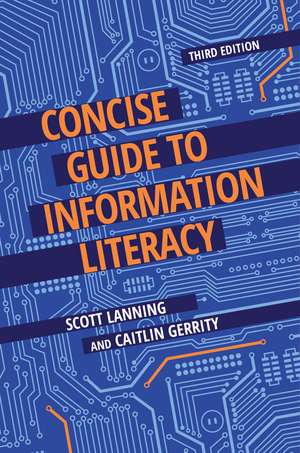Concise Guide to Information Literacy
Autor Scott Lanning, Caitlin Gerrityen Limba Engleză Paperback – 14 feb 2022 – vârsta până la 17 ani
Preț: 305.11 lei
Preț vechi: 353.40 lei
-14% Nou
Puncte Express: 458
Preț estimativ în valută:
58.38€ • 61.24$ • 48.60£
58.38€ • 61.24$ • 48.60£
Carte tipărită la comandă
Livrare economică 01-15 aprilie
Preluare comenzi: 021 569.72.76
Specificații
ISBN-13: 9781440878190
ISBN-10: 1440878196
Pagini: 224
Dimensiuni: 156 x 235 mm
Greutate: 0.36 kg
Ediția:3
Editura: Bloomsbury Publishing
Colecția Libraries Unlimited
Locul publicării:New York, United States
ISBN-10: 1440878196
Pagini: 224
Dimensiuni: 156 x 235 mm
Greutate: 0.36 kg
Ediția:3
Editura: Bloomsbury Publishing
Colecția Libraries Unlimited
Locul publicării:New York, United States
Caracteristici
Furnishes librarians and teachers with a concise textbook that is useful for student instruction and as a research guide
Notă biografică
Scott Lanning is associate professor and librarian at Southern Utah University, Cedar City, UT.Caitlin Gerrity is associate professor and librarian at Southern Utah University, Cedar City, UT.
Cuprins
List of FiguresPrefaceChapter 1: Information and Information LiteracyQuestions to Guide Your ReadingIntroductionWhat Is Information?Information SourcesWhat Does It Mean to Be Literate?What Is Information Literacy?Why Is Information Literacy Important?VocabularyQuestions for ReflectionAssignmentReferencesChapter 2: Information Literacy and the LibraryQuestions to Guide Your ReadingIntroductionLibrary AnxietyThe LibrarianResearch HelpInterlibrary LoanLibrary InstructionThe Research ProcessVocabularyQuestions for ReflectionAssignmentReferencesChapter 3: Curiosity, the Information Need, and the Research QuestionQuestions to Guide Your ReadingCuriosityCuriosity and LearningCuriosity and MotivationInformation NeedFormulating and Reformulating the Research QuestionVocabularyQuestions for ReflectionAssignmentReferencesChapter 4: The Types of Information and Its SourcesQuestions to Guide Your ReadingThe Organization of Academic Knowledge and Publishing LiteracyParts of InformationOriginAudienceTimeFormats of InformationPhysicalDigitalTypes of InformationBackground Information SourcesBooksNews SourcesMagazinesJournalsIncluding Diverse PerspectivesVocabularyQuestions for ReflectionAssignmentReferencesChapter 5: Exploring the Information Landscape and Finding ResourcesQuestions to Guide Your ReadingChoosing the Right Search ToolWhat Is a Database?Free DatabasesFee DatabasesSearching Library DatabasesChoosing a DatabaseAccessing the Information in DatabasesFederated Searching and Discovery LayersSearching DatabasesBasic SearchAdvanced SearchPhrase SearchingBoolean OperatorsNestingStemmingRevising the SearchChoosing KeywordsUsing Subject Searching and Field SearchingFacetsSearching the Library CatalogRetrieving MaterialsSearching the WebWeb Search EnginesAdvanced SearchingVocabularyQuestions for ReflectionAssignmentReferencesChapter 6: Evaluating Research and InformationQuestions to Guide Your ReadingEvaluation and Critical ThinkingEvaluating Sources Found through the Library CatalogRelevancePurposeScope and DepthStyleValidityTimelinessAuthorityAccuracyEvaluating ArticlesRelevancePurposeScope and DepthStyleValidityTimelinessAuthorityAccuracyEvaluating WebsitesRelevancePurposeScope and DepthStyleValidityTimelinessAuthorityAccuracyEvaluation of Your Research ProcessResearch QuestionSearch StatementKeywordsDatabase SelectionDiverse and Inclusive SourcesVocabularyQuestions for ReflectionAssignmentReferencesChapter 7: Research Management and Your Role in the Research CommunityQuestions to Guide Your ReadingUsing Information EthicallyCitationsCitation StylesStyle GuidesResearch ManagementDatabase Research ManagementResearch Management SoftwareInserting Citations and Bibliographies into Research PapersResearch CommunityScholarly CommunicationsVocabularyQuestions for ReflectionAssignmentReferencesChapter 8: Creating a Product and Using InformationQuestions to Guide Your ReadingUsing InformationIntellectual Property and CopyrightFair UsePlagiarismQuoting, Paraphrasing, and Summarizing InformationSynthesizing InformationUsing Library ResourcesUsing Electronic SourcesUsing Web SourcesVocabularyQuestions for ReflectionAssignmentReferencesChapter 9: Critically Reflecting and Sharing Your ProductQuestions to Guide Your ReadingOrganizationLogicProofreadingCritically ReflectingCommunicating Your FindingsClassroom CommunicationProfessional CommunicationThe TakeawayVocabularyQuestions for ReflectionAssignmentReferencesBibliographyIndex
